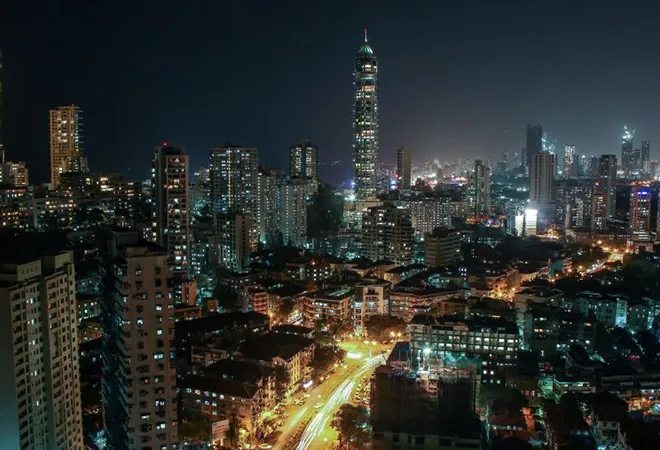
This article is part of the series — Colaba Edit.
Mumbai has played a key role in India’s global positioning. From presenting India as an investment destination to projecting its products, services, entrepreneurs and opportunities abroad, Mumbai’s business leaders have served as economic diplomats for the nation.
As the focus of geopolitics now moves from the ‘Asia Pacific’ to the ‘Indo-Pacific,’ Mumbai has an opportunity to position itself as a vibrant centre of geoeconomics for the region.
The Indo-Pacific is a commonly understood construct in global strategic networks, but it is less familiar in business circles. The construct was first suggested by former Japanese Prime Minister Shinzo Abe in his speech at the Indian parliament in 2007, extending the Pacific-focused security framework to India and the African east coast. The notion has since grown in geopolitical significance with the rise of an antagonistic China, leading to an expansion of the United States Pacific Command to the Indo-Pacific Command in May 2018, the spawning of the Quad military cooperation framework between Japan, Australia, the US and India, and the launch of a new division for the Indo-Pacific by India’s Ministry of External Affairs to focus on strategic developments.
The Indo-Pacific is a commonly understood construct in global strategic networks, but it is less familiar in business circles.
A similar evolution in geoeconomics, however, from Asia-Pacific to Indo-Pacific, has not happened. The economic and business integration is upheld by the Asia-Pacific Economic Cooperation (APEC; which excludes India) established in the early 1990s with the US, China and Japan as its primary constituents. In 2020, more than half of intra-Asia Pacific merchandise trade was led by US, China and Japan. The integration is deeper in specific sectors such as electronics. This has influenced how regional businesses have developed their operations. Nearly 340,000 business executives use the APEC Business Travel Card to move freely between their offices.
An analogous economic framework for the Indo-Pacific is missing. The absence of India and the US from Regional Comprehensive Economic Partnership and the Trans-Pacific Partnership indicates that the Indo-Pacific geoeconomics is not congruent with the geopolitical imperatives of the region. This has implications for India and specifically Mumbai, which is expected to reposition its economic outreach in the region without a commensurate economic architecture to plug into.
An analogous economic framework for the Indo-Pacific is missing.
The Indo-Pacific is a formidable space of geoeconomically powerful cities such as Singapore, Hong Kong, Shanghai, Shenzhen, Sydney, Dubai and Tokyo. Hong Kong has been the most vibrant IPO centre with over 2500 listed companies worth US$6 trillion, and unique access to mainland Chinese enterprises and financial markets. Singapore has deep wealth management expertise with nearly US$3 trillion in assets under management, most of which was sourced and deployed in the region. Shenzhen, Shanghai and Beijing have risen with the globalisation of China’s state-owned enterprises. To India’s west is Dubai, an established financial centre with access to US$3 trillion in the region’s sovereign wealth funds.
This league also has other new entrants. Fintech has now launched Los Angeles and San Francisco as global financial centres. San Francisco was ranked at the ninth position, ahead of Zurich, Luxembourg and Frankfurt, in the latest global financial centres report — a significant development for the geoeconomics of the Indo-Pacific.
It helps the city that India’s central bank, securities regulator, largest private and public sector banks, equity and commodity exchanges and export-import bank are headquartered in Mumbai.
Mumbai’s Bombay Stock Exchange (BSE), with US$3.6 trillion in market capitalisation, and the National Stock Exchange, with US$2 trillion in market capitalisation, are smaller than Hong Kong but increasingly competitive. The BSE already has over 5000 companies listed on its bourse, the highest in the world. Similarly, India was the second-largest market for private equity in 2019 after China but was growing more rapidly, particularly for the internet and technology sectors in which India has produced more than 20 unicorns since 2013. It helps the city that India’s central bank, securities regulator, largest private and public sector banks, equity and commodity exchanges and export-import bank are headquartered in Mumbai.
As a business centre, Mumbai’s economic power depends directly on the strength of the corporates based in the city. Indian multinationals such as Tata Sons, Reliance Industries, Mahindra, Godrej and subsidiaries of foreign multinationals such Hindustan Unilever, Morgan Stanley and Citibank have defined the city’s corporate culture and global economic integration.
An invitation to relocate usually implies a promotion and an opportunity to experience the pulse of ‘Asia Pacific’ from within.
Nevertheless, attracting multinationals to Mumbai is a difficult task. Nearly, half of the regional headquarters of global companies are based in Singapore, many of them technology firms, not finance (contrary to popular understanding). A 2007 survey indicating that 40 percent of American and 40 percent of European technology companies had their regional headquarters in Singapore is telling of the history of effort the city-state has put in to attract corporations.
Given that most western businesses have Asia Pacific headquarters in Singapore or Hong Kong with the purview of supervising Indian subsidiaries, the two cities have also been aspirational destinations for Mumbai-based business professionals. An invitation to relocate usually implies a promotion and an opportunity to experience the pulse of ‘Asia Pacific’ from within.
The most significant multilateral economic convention Mumbai chaired was the Asian Infrastructure Investment Bank annual meetings in 2018.
By 2019, investments from the US and Europe in real-estate in the Asia Pacific were being gradually replaced by investments from Singapore, South Korea, Japan and China, indicating that successful Asian enterprises and regional geoeconomics will determine the next best location for regional business. Ho Chi Minh City in Vietnam, for instance, that has benefited from the manufacturing leaving China, and Bangkok, Thailand, is becoming more attractive for western expats than Hong Kong.
Some of the cities have also played an outsised role in global economic affairs. For instance, Singapore is a permanent invitee to the G20, is home to the APEC Secretariat and hosted the APEC Summit twice. Singapore’s finance minister was the first Asian to chair the prestigious International Monetary and Financial Committee of the IMF in 2011. Hong Kong chaired the IMF/World Bank annual meetings in 1997 and the 2005 World Trade Organisation ministerial meeting. Both cities are independently represented at the Financial Stability Board established by the G20. Japan and Australia have hosted the G20 in 2019 and 2014, allowing cities such as Osaka and Sydney to convene government and business leaders from the most powerful economies. Kuala Lumpur, Malaysia, has hosted the APEC Summit twice and Bangkok is set to host it for the third time in 2022.
Competition is fierce from the other economic powerhouses in the region.
In contrast, Mumbai has less experience to project. The most significant multilateral economic convention Mumbai chaired was the Asian Infrastructure Investment Bank annual meetings in 2018. The BRICS New Development Bank annual meeting was held in New Delhi in 2017, not in Mumbai. India is yet to chair the G20, but the working group meetings it has hosted were held in Kumarakom, Kerala, in 2015 and Varanasi, Uttar Pradesh, in 2017 — noble attempts to build convening capacity outside of the metros but at the cost of losing business participation in global economic policymaking.
The unrest in Hong Kong and China’s increasing focus on its domestic economy is likely to open opportunities for Mumbai to play a larger role in the region. But competition is fierce from the other economic powerhouses in the region. The weak reaction from multinationals to the Supply Chain Resistance Initiative launched by Australia, Japan and India to shift supply chains away from China shows that convincing business to align with geopolitics is hard.
Mumbai has one strength other cities in the region do not — a booming creative industry.
Positioning Mumbai in the Indo-Pacific will require planning. A new version of the ‘Bombay Plan’ — Bombay Plan 2.0 — is needed to build on the original vision articulated by industrialists in 1945 to reposition the city for the new geoeconomics.
India’s presidency of BRICS in 2021 and G20 in 2023 are good opportunities to give Mumbai a chance to showcase its leadership in the region on business and finance.
Another idea is to establish a Mumbai Economic Development Board along the lines of Singapore’s Economic Development Board to attract multinationals to the city, project its strength as a financial and business centre, and develop infrastructure to support these ambitions.
Finally, Mumbai has one strength other cities in the region do not — a booming creative industry. Mumbai is the nation’s capital for cinema, advertising and print media, infusing a unique dimension to the city’s character. India is the largest market globally for newspapers and films by volume, and the third-largest cinema market by revenue in Asia (after China and Japan), most of which is generated in Mumbai. Mumbai indeed has all the branding and soft power needed to mark Mumbai as the leading city for geoeconomics.
The views expressed above belong to the author(s). ORF research and analyses now available on Telegram! Click here to access our curated content — blogs, longforms and interviews.




 PREV
PREV


